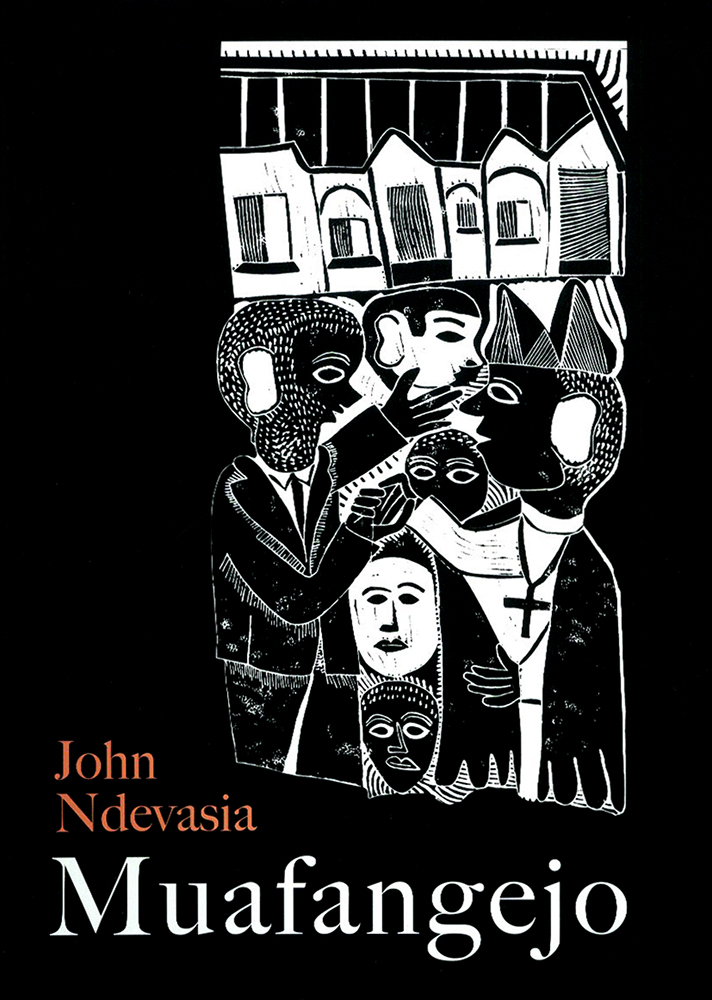John Ndevasia Muafangejo, by Adelheid Lilienthal et al.

John Ndevasia Muafangejo, by Adelheid Lilienthal et al. Arts Association Heritage Trust / Arts Association of Namibia. Windhoek, Namibia 2010. ISBN 9789994571116 / ISBN 978-99945-71-11-6
John Ndevasia Muafangejo: This is a beautifully made exhibition catatogue featuring the artwork of a famous Namibian artist, by Adelheid Lilienthal et al. dating from 2010.
A lot has been written about John Ndevashija Mwafangejo. I don't even think that I can say anything about him that has not been said before. People have taken pains to interpret his work. I admire them. I was reading an article in the Weekender of May 2002 about John Mwafangeyo, very beautiful article by Erica Gebhardt. I picked up a couple of interpretations which, in my opinion, need to be revisited. Both concern John's name. One interpretation says that the name Ndevashija was replaced by the name John at his baptism. As far as I know it was not the policy of the Anglican Church of the time to "replace" traditional names with Christian ones. It was however the policy of the Anglican Church to give Christian names to be added to the traditional ones. The Christian name always became the first name. All the names were entered in the Baptism Register. But for two reasons the second name almost always fell by the wayside. The first reason was that the early white people were not keen to learn to pronounce black names. The second reason came from the newly baptised candidates themselves. Out of their zeal and enthusiasm for the new life they would prefer that their new name be used. On page 3 of the same Weekender there is a 1986 work by John in which John writes his name as Mwangejo. The following is Margo Timm-Forster's interpretation: "By changing his name from Mwafangejo to Mwangejo which means 'y°u belong to me' the artist is affirming his right as a 'Namibian' to freedom of movement and freedom of association with any place of his choice." My opinion is two-fold: John misspells his name by accident and ignored it as it did not spoil his theme. It was in fact too difficult to undo. Secondly, John was not known to express himself by changing his name. It must also be noted that once an Oshiwambo word's spelling is changed, the meaning changes also. Lucky if the new meaning is not an insult. The last observation comes from a beautiful, 17 page booklet (copies kept in the archives at Odibo). It is difficult to know who the author was since the first six pages are missing. The foreword, which appears on page 7, was signed by Nelson Mandela in 1992. On page 9 the author speaks about Kwanyama proverbs which were frequently used by the tribe in their daily life which also influenced John's thinking. The author gives the following one as an example: "Ounyuni wokambiya, wai pombada, wai p'osi ('the world is like a pot full of sorghum grain, now up, now down') a reference to a pot that is swung up and down between two sticks. Both the translation and the interpretation of the above proverb need to be amended, only slightly. The Oshikwanyama version of the proverb lacks a key word 'sorghum' that the author correctly provides in the English translation. It should go like this: Ounyuni owakambiya kamahola, wa i pombada, wa i poshi. The interpretation requires complete overhaul. [...]
This is an excerpt from John Ndevasia Muafangejo, by Adelheid Lilienthal et al.
Title: John Ndevasia Muafangejo
Genre: Exhibition Catalogue
Author: Adelheid Lilienthal
Editor: Helen Vale
Research: Gerhard van der Westhuizen, Elize van der Westhuizen
Layout: Haiko Bruns
Publisher: Arts Association Heritage Trust / Arts Association of Namibia
Windhoek, Namibia 2010
ISBN 9789994571116 / ISBN 978-99945-71-11-6
Softcover, 21 x 29 cm, 124 pages, throughout b/w images
Lilienthal, Adelheid im Namibiana-Buchangebot
John Ndevasia Muafangejo
A catalogue of John Ndevasia Muafangejo's (1943-1987) artwork exhibited in the National Art Gallery of Namibia in 2009/2010.
Joachim Voigts
Die Nachkommen von Joachim Voigts veranstalteten 2007 eine Gedächtnisausstellung zum 100. Geburtstag des namibischen Künstlers.
Das Erdmännchen, ein Lesespaß. Lesebuch für die Grundstufe
Das Erdmännchen - Ein Lesespaß. Lesebuch für die Grundstufe. Erstes Zusatzleseheft für den Deutschunterricht von Sub A- Std. II Taschenbuch, 1989.
Hart wie Kameldornholz. Ein deutscher Südwester erlebt Namibias Unabhängigkeitswerdung 1986-1991
Comic: Hart wie Kameldornholz - wie ein deutscher Südwester die Höhen und Tiefen der Unabhängigkeitswerdung in den Jahren 1986-1991 Namibias miterlebt.
Vom Schutzgebiet bis Namibia 2000
Mit 62 Beiträgen zur älteren und jüngsten Geschichte bis 2000 des ehemaligen Schutzgebiets und des heutigen Namibia.







